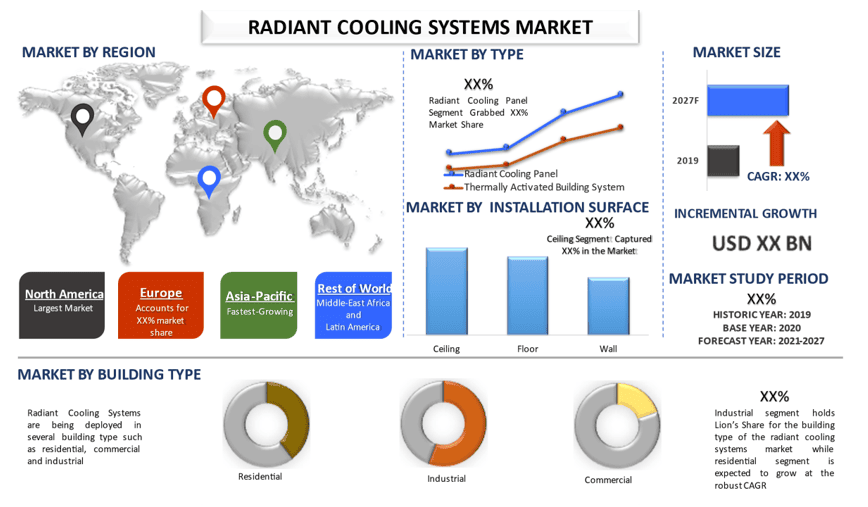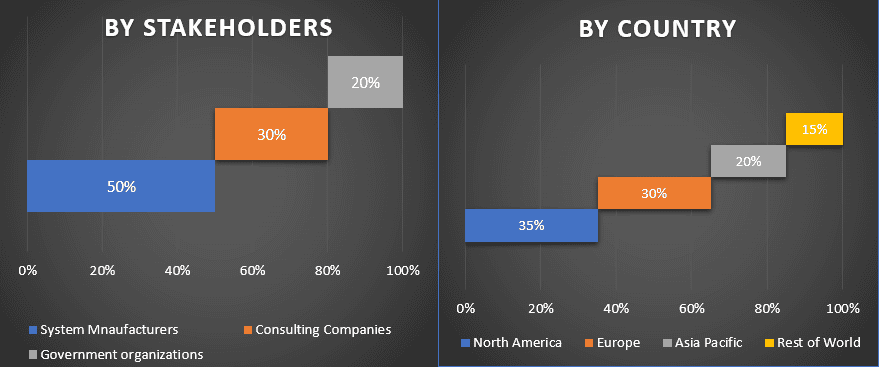- الرئيسية
- معلومات عنا
- صناعة
- الخدمات
- قراءة
- اتصل بنا
سوق أنظمة التبريد المشع: التحليل الحالي والتوقعات (2021-2027)
التركيز على النوع (أنظمة البناء المُنشَّطة حراريًا، ألواح التبريد الإشعاعي)؛ سطح التركيب (الأرضية، الجدار، السقف)؛ نوع المبنى (سكني، صناعي، تجاري)؛ منطقة التطبيق (مبانٍ جديدة، مبانٍ قائمة/تجديد)؛ المنطقة/الدولة

من المتوقع أن يُظهر سوق أنظمة التبريد المشع العالمية معدل نمو سنوي مركب مرتفع يبلغ حوالي 4.5٪ خلال الفترة المتوقعة (2021-2027)
يُعزى النمو في الطلب على أنظمة التبريد المشع إلى عدة عوامل رئيسية مثل التوسع الحضري السريع، وزيادة عدد المدن الذكية، وارتفاع الدخل المتاح. ووفقًا للأمم المتحدة، يعيش الآن 56.2% من سكان العالم في المدن، ويعيش نصف هؤلاء الأشخاص في بلدات يقل عدد سكانها عن 500,000 نسمة. لقد نما عدد سكان العالم في المناطق الحضرية بسرعة من 751 مليون نسمة في عام 1950 إلى 4.2 مليار نسمة في عام 2018. وتضم آسيا، على الرغم من انخفاض مستوى التحضر فيها نسبيًا، 54% من سكان المناطق الحضرية في العالم، تليها أوروبا وأفريقيا بنسبة 13% لكل منهما. واليوم، تشمل المناطق الأكثر تحضرًا أمريكا الشمالية (حيث يعيش 82% من سكانها في المناطق الحضرية في عام 2018)، وأمريكا اللاتينية ومنطقة البحر الكاريبي (81%)، وأوروبا (74%)، وأوقيانوسيا (68%). ويقترب مستوى التحضر في آسيا الآن من 50%. وفي المقابل، لا تزال أفريقيا ريفية في الغالب، حيث يعيش 43% من سكانها في المناطق الحضرية.
إن ارتفاع الطلب على الطاقة، إلى جانب ارتفاع تعريفة الكهرباء في مختلف البلدان، يعمل أيضًا كمحفز للنمو في السوق. على سبيل المثال، وفقًا لوكالة الطاقة الدولية (IEA)، من المتوقع أن يصل استهلاك الكهرباء في القطاع السكني في الولايات المتحدة إلى 1,484 مليار كيلو وات في الساعة بحلول عام 2023، ارتفاعًا من 1,440 مليار كيلو وات في الساعة في عام 2019.
علاوة على ذلك، فإن الزيادة في قطاع البناء، وظهور القطاع الصناعي، والقطاع التجاري في البلاد يدفع نمو سوق أنظمة التبريد المشع. وفقًا لـ CEIC، ارتفع الإنتاج الصناعي في الولايات المتحدة بنسبة 3.7% على أساس سنوي في ديسمبر 2021، بعد زيادة بنسبة 5.0% على أساس سنوي في الشهر السابق.
استهلاك الطاقة الصناعية العالمي في سيناريو التنمية المستدامة، 2019-2070

تعد شركة Jardine Engineering Corporation (JEC) وGiacomini Spa وRehau وRadiana Ltd. وBeKa Heiz وPillarPlus Inc. وOorja Energy Engineering Services Pvt Ltd وSusPower L.L.C. وMessana Radiant Cooling وMrPEX Systems، وما إلى ذلك، من بين اللاعبين البارزين العاملين في سوق أنظمة التبريد المشع. وقد قام هؤلاء اللاعبون بالعديد من عمليات الاندماج والاستحواذ بالإضافة إلى الشراكات لتسهيل حصول العملاء على المنتجات المبتكرة ذات التقنية العالية.
الرؤى المقدمة في التقرير
"من بين الأنواع، تستحوذ الألواح المشعة على الحصة الأكبر"
بناءً على النوع، ينقسم السوق إلى أنظمة المباني المنشطة حرارياً والألواح المشعة. استحوذ قطاع الألواح المشعة على الحصة الأكبر في السوق وهيمن على السوق في عام 2020. وسيصل سوق هذا القطاع إلى XX مليون دولار أمريكي بحلول عام 2027. تعتبر الألواح المشعة فعالة للغاية للتبريد لأنها تعمل في درجات حرارة عالية نسبيًا (عادةً 15-19 درجة مئوية). إن الزيادة في قطاع البناء تؤدي إلى زيادة الطلب على الألواح المشعة
"من بين مجالات التطبيق، من المتوقع أن يستحوذ قطاع المباني القائمة/التجديد على حصة سوقية كبيرة"
بناءً على مجال التطبيق، ينقسم السوق إلى مبانٍ جديدة ومبانٍ قائمة/تجديد. استحوذ قطاع المباني القائمة/التجديد على حصة سوقية تبلغ XX% واستحوذ على سوق بقيمة XX مليون دولار أمريكي في عام 2020. ومع ذلك، سيشهد قطاع المباني الجديدة معدل نمو سنوي مركب قوي خلال السنوات القادمة
"من بين أسطح التركيب، من المتوقع أن يستحوذ قطاع السقف على حصة سوقية كبيرة في السنوات القادمة"
بناءً على سطح التركيب، ينقسم السوق إلى الأرضية والجدار والسقف. استحوذ قطاع السقف على حصة سوقية تبلغ XX% واستحوذ على سوق بقيمة XX مليون دولار أمريكي في عام 2020. ومع ذلك، سيشهد القطاع المفضل معدل نمو سنوي مركب قوي خلال السنوات القادمة. خلال فصل الصيف، يضمن نظام السقف السطحي مناخًا داخليًا لطيفًا دون آثار ضارة لتكييف الهواء مثل دوران الهواء البارد واستهلاك الطاقة العالي
"من بين أنواع المباني، من المتوقع أن يستحوذ القطاع السكني على حصة سوقية كبيرة"
بناءً على نوع المبنى، ينقسم السوق إلى سكني وصناعي وتجاري. استحوذ القطاع الصناعي على حصة سوقية تبلغ XX% في عام 2020. تمثل الصناعة التحويلية أكثر من 30% من إجمالي استخدام الطاقة في جميع أنحاء العالم. ومع ذلك، سيشهد القطاع السكني معدل نمو سنوي مركب كبير في السنوات القادمة
"تمثل أمريكا الشمالية واحدة من أكبر أسواق سوق أنظمة التبريد المشع"
لتحسين فهم ديناميكيات سوق أنظمة التبريد المشع، تم إجراء تحليل تفصيلي لمختلف المناطق في جميع أنحاء العالم، بما في ذلك أمريكا الشمالية وأوروبا وآسيا والمحيط الهادئ وبقية العالم. هيمنت منطقة أمريكا الشمالية على السوق وحققت حصة الإيرادات الرائدة في عام 2020. كما أن التصنيع السريع وتوسع القطاع التجاري في دول مثل الولايات المتحدة وكندا يتطلبان أيضًا أنظمة تبريد مشعة
أسباب شراء هذا التقرير:
- تتضمن الدراسة تحليلًا لحجم السوق والتنبؤات تم التحقق من صحتها من قبل خبراء الصناعة الرئيسيين الموثوقين
- يقدم التقرير مراجعة سريعة للأداء العام للصناعة في لمحة
- يغطي التقرير تحليلًا متعمقًا لنظراء الصناعة البارزين مع التركيز الأساسي على البيانات المالية الرئيسية للأعمال، ومحفظة المنتجات، واستراتيجيات التوسع، والتطورات الأخيرة
- فحص مفصل للدوافع والمعوقات والاتجاهات الرئيسية والفرص السائدة في الصناعة
- تغطي الدراسة بشكل شامل السوق عبر مختلف القطاعات
- تحليل إقليمي متعمق للصناعة
خيارات التخصيص:
يمكن تخصيص سوق أنظمة التبريد المشع بشكل أكبر وفقًا للمتطلبات أو أي قطاع سوق آخر. إلى جانب ذلك، تدرك UMI أن لديك احتياجات عملك الخاصة، لذا لا تتردد في التواصل معنا للحصول على تقرير يناسب متطلباتك تمامًا.
جدول المحتويات
تمثلت الخطوات الرئيسية الثلاث التي تم اتخاذها لإنشاء وتحليل الطلب على أنظمة التبريد المشع في تحليل السوق التاريخي، وتقدير السوق الحالي، والتنبؤ بسوق أنظمة التبريد المشع المستقبلي عبر المناطق الرئيسية. تم إجراء بحث ثانوي شامل لجمع أرقام السوق التاريخية وتقدير حجم السوق الحالي. ثانيًا، للتحقق من صحة هذه الرؤى، تم أخذ العديد من النتائج والافتراضات في الاعتبار. علاوة على ذلك، تم إجراء مقابلات أولية شاملة أيضًا مع خبراء الصناعة عبر سلسلة القيمة لسوق أنظمة التبريد المشع. بعد افتراض أرقام السوق والتحقق من صحتها من خلال المقابلات الأولية، استخدمنا نهجًا من أعلى إلى أسفل / من أسفل إلى أعلى للتنبؤ بحجم السوق الكامل. بعد ذلك، تم اعتماد طرق تقسيم السوق والتثليث لتقدير وتحليل حجم سوق القطاعات والقطاعات الفرعية التي تنتمي إليها الصناعة. يتم شرح المنهجية التفصيلية أدناه:
اطلب المزيد من التفاصيل حول منهجية البحث
تحليل حجم السوق التاريخي
الخطوة 1: دراسة متعمقة للمصادر الثانوية:
تم إجراء دراسة ثانوية مفصلة للحصول على حجم السوق التاريخي لأنظمة التبريد المشع من خلال مصادر الشركة الداخلية مثل التقارير السنوية والبيانات المالية وعروض الأداء والنشرات الصحفية وما إلى ذلك، والمصادر الخارجية بما في ذلك المجلات والأخبار والمقالات والمنشورات الحكومية ومنشورات المنافسين وتقارير القطاعات وقاعدة بيانات الطرف الثالث والمنشورات الموثوقة الأخرى.
الخطوة 2: تقسيم السوق:
بعد الحصول على حجم السوق التاريخي لسوق أنظمة التبريد المشع، أجرينا تحليلًا ثانويًا مفصلاً لجمع رؤى السوق التاريخية وحصتها من حيث النوع وسطح التركيب ومنطقة التطبيق ونوع المبنى للمناطق الرئيسية. تشمل القطاعات الرئيسية المدرجة في التقرير النوع ونوع المبنى. تم إجراء مزيد من التحليلات على مستوى المنطقة والبلد لتقييم الاعتماد الكلي لأنظمة التبريد المشع في جميع أنحاء العالم.
الخطوة 3: تحليل العوامل:
بعد الحصول على حجم السوق التاريخي للقطاعات والقطاعات الفرعية المختلفة، أجرينا تحليلًا تفصيليًا للعوامل لتقدير حجم السوق الحالي لأنظمة التبريد المشع. علاوة على ذلك، أجرينا تحليلًا للعوامل باستخدام متغيرات تابعة ومستقلة مثل ارتفاع الطلب على الأنظمة الموفرة للطاقة، وارتفاع الطلب على المنازل الذكية، وما إلى ذلك. تم إجراء تحليل شامل لسيناريوهات جانب الطلب والعرض مع الأخذ في الاعتبار أهم الشراكات والاندماج والاستحواذ والتوسع التجاري وإطلاق المنتجات في صناعة أنظمة التبريد المشع في جميع أنحاء العالم.
تقدير حجم السوق الحالي والتنبؤ به
حجم السوق الحالي: بناءً على رؤى قابلة للتنفيذ من الخطوات الثلاث المذكورة أعلاه، توصلنا إلى حجم السوق الحالي واللاعبين الرئيسيين في سوق أنظمة التبريد المشع والحصص السوقية للقطاعات. تم تحديد جميع تقسيمات الأسهم المئوية المطلوبة وتقسيمات السوق باستخدام النهج الثانوي المذكور أعلاه وتم التحقق منها من خلال المقابلات الأولية.
التقدير والتنبؤ: لتقدير السوق والتنبؤ به، تم تخصيص ترجيح لعوامل مختلفة بما في ذلك المحركات والاتجاهات والقيود والفرص المتاحة لأصحاب المصلحة. بعد تحليل هذه العوامل، تم تطبيق تقنيات التنبؤ ذات الصلة، أي النهج من أسفل إلى أعلى / من أعلى إلى أسفل، للتوصل إلى توقعات السوق حول عام 2027 للقطاعات والقطاعات الفرعية المختلفة عبر الأسواق الرئيسية على مستوى العالم. تشمل منهجية البحث المعتمدة لتقدير حجم السوق ما يلي:
- حجم سوق الصناعة، من حيث القيمة (بالدولار الأمريكي) ومعدل اعتماد أنظمة التبريد المشع في جميع أنحاء الأسواق الرئيسية محليًا
- جميع الأسهم المئوية وتقسيمات وتقسيمات قطاعات السوق وقطاعاته الفرعية
- اللاعبون الرئيسيون في سوق أنظمة التبريد المشع من حيث الخدمات المقدمة. أيضًا، استراتيجيات النمو التي يتبناها هؤلاء اللاعبون للتنافس في السوق سريع النمو
التحقق من حجم السوق والحصة السوقية
البحث الأولي: تم إجراء مقابلات متعمقة مع قادة الرأي الرئيسيين (KOLs) بما في ذلك كبار المديرين التنفيذيين (CXO/VPs ورئيس المبيعات ورئيس التسويق والرئيس التشغيلي والرئيس الإقليمي ورئيس الدولة وما إلى ذلك) عبر المناطق الرئيسية. ثم تم تلخيص نتائج البحث الأولي وإجراء تحليل إحصائي لإثبات الفرضية المذكورة. تم دمج المدخلات من البحث الأولي مع النتائج الثانوية، وبالتالي تحويل المعلومات إلى رؤى قابلة للتنفيذ.
تقسيم المشاركين الأساسيين في مناطق مختلفة

هندسة السوق
تم استخدام تقنية تثليث البيانات لإكمال تقدير السوق الإجمالي وللوصول إلى أرقام إحصائية دقيقة لكل قطاع وقطاع فرعي من سوق أنظمة التبريد المشع. تم تقسيم البيانات إلى عدة قطاعات فرعية بعد دراسة مختلف المعلمات والاتجاهات في مجالات النوع وسطح التركيب ومنطقة التطبيق ونوع المبنى لسوق أنظمة التبريد المشع.
الهدف الرئيسي من دراسة سوق أنظمة التبريد المشع
تم تحديد اتجاهات السوق الحالية والمستقبلية لأنظمة التبريد المشع في الدراسة. يمكن للمستثمرين اكتساب رؤى استراتيجية لتوظيفها في استثماراتهم من التحليل النوعي والكمي الذي تم إجراؤه في الدراسة. تم تحديد اتجاهات السوق الحالية والمستقبلية للجاذبية الإجمالية للسوق على المستوى الإقليمي، مما يوفر منصة للمشارك الصناعي لاستغلال السوق غير المستغلة للاستفادة كميزة المحرك الأول. تشمل الأهداف الكمية الأخرى للدراسات ما يلي:
- تحليل حجم السوق الحالي والمتوقع لأنظمة التبريد المشع من حيث القيمة (بالدولار الأمريكي). أيضًا، قم بتحليل حجم السوق الحالي والمتوقع للقطاعات والقطاعات الفرعية المختلفة
- تشمل القطاعات في الدراسة مجالات النوع وسطح التركيب ومنطقة التطبيق ونوع المبنى
- تحديد وتحليل الإطار التنظيمي لصناعة أنظمة التبريد المشع
- تحليل سلسلة القيمة التي تنطوي على وجود وسطاء مختلفين، إلى جانب تحليل سلوكيات العملاء والمنافسين في الصناعة
- تحليل حجم السوق الحالي والمتوقع لسوق أنظمة التبريد المشع للدول الرئيسية
- تشمل المنطقة الرئيسية التي تمت دراستها في التقرير أمريكا الشمالية وأوروبا وآسيا والمحيط الهادئ وبقية العالم.
- ملفات تعريف الشركة لسوق أنظمة التبريد المشع واستراتيجيات النمو التي يتبناها اللاعبون في السوق للاستمرار في السوق سريع النمو
- تحليل إقليمي متعمق للصناعة
ذات صلة التقارير
العملاء الذين اشتروا هذا المنتج اشتروا أيضًا










